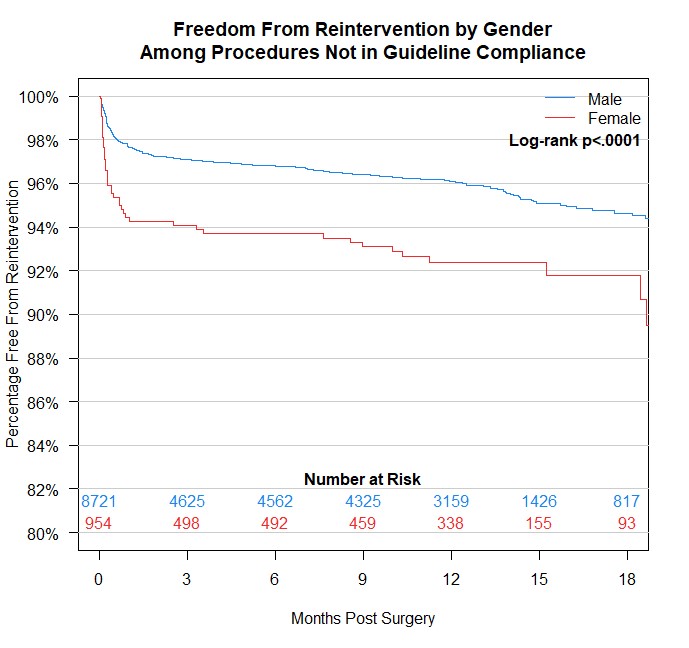Non-Guideline Compliant EVAR in Women is Associated with Increased Mortality and Re-intervention Compared to Men
Sadia Ilyas1, David H. Stone1, Jeanwan Kang1, Michol Cooper2, Jesse Columbo1, Thomas Huber2, Bjoern Suckow1, Philip Goodney1, Richard Powell1, Salvatore Scali2
1Dartmouth-Hitchcock Medical Center, Lebanon, NH, 2University of Florida, Gainesville, FL
Introduction: Gender based disparities in surgical outcomes have emerged as an important focus in contemporary healthcare delivery. Likewise, the appropriate utilization of endovascular AAA repair (EVAR) in the United States remains a subject of ongoing controversy, with a significant number of U.S. EVARs failing to adhere to Society for Vascular Surgery (SVS) clinical practice guideline (CPG) diameter thresholds for repair. The purpose of this study was to determine the impact of gender among patients undergoing EVAR that is non-compliant with SVS CPGs. Methods: All elective EVAR procedures for AAA without concomitant iliac aneurysm (≥3.0cm) in the SVS VQI were analyzed (2015-2019; N=25,112). SVS CPG non-compliant repairs were defined as men <5.5cm and women <5.0cm. The primary end-point was 30-day mortality. Secondary end-points included all-cause mortality, complications and re-intervention. Logistic regression was performed to control for surgeon and patient level factors. Freedom from end-points was determined using Kaplan Meier methodology.Results: Non-compliant EVAR was performed in 38.5% (N=9675) of patients. While men were significantly more likely to undergo these procedures (men, 90% vs. women 10%: OR 3.1, 95%CI 2.9-3.4; P<.0001), 30-day mortality was greater among women vs. men (1.8% vs. 0.5%; P=.0003). Women also experienced significantly higher rates of multiple complications including postoperative MI (1% vs. 0.3%; P=.006), respiratory failure (1.4% vs. 0.6%; P=.01), intestinal ischemia (0.7% vs. 0.2%; P=.003), access vessel hematoma (3% vs. 1.2%; P =.0006), and iliac access vessel injury (2.4% vs. 0.8%; P<.0001). Additionally, women experienced increased overall 1-year re-intervention rates (11.5% vs. 5.8%; P<.0001).In adjusted analysis, 30-day mortality, and any in-hospital complication risk remained significantly greater among women (30-day death, OR 3.1, 95%CI 1.6-5.8; P=.0005, in-hospital complication, OR 1.9, 1.4-2.6; P<.0001). Women also experienced increased re-intervention rates over time compared to men (OR 1.5, 1.1-2.2; P=.02) (Figure).Conclusions: Though men were more likely to undergo non-guideline compliant EVAR, women experienced increased short-term morbidity and 30-day mortality, as well as higher rates of re-intervention when failing to meet anatomic guidelines for repair. These alarming findings necessitate increased scrutiny on current U.S. gender based EVAR practice and should caution non-guideline compliant EVAR delivery in women.
Back to 2021 Abstracts

